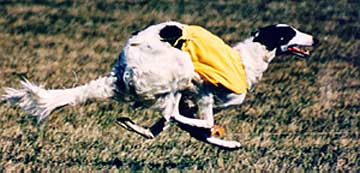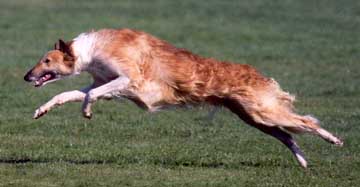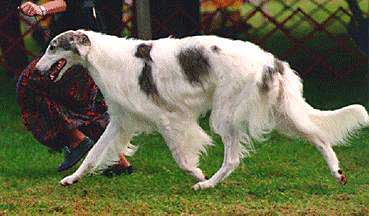|
Since the topline is the foundation of any dog, and seems to
be the most mis-
understood part of the Borzoi, we will start off the practical
education about the breed on that subject.
There is much disinformation about Borzoi topline that has
become part of the dog world's collective consciousness, as well
as that of the casually interested public. This is due to two
major factors: first, the mental image from Art Deco times, and
secondly, the fact that there are a lot of Borzoi out there with
faulty toplines for us to see
Taking the mystery out of
THE BORZOI TOPLINE
Patti Widick Neale © 1995
 The sweeping lines of the Borzoi
have been an inspiration to artists and designers over the last
century and the exaggeration of the details that make the Borzoi
different from a generic dog have been carried to an extreme
in both representative and decorative art, particularly in the
Deco period. Length of leg and head, fineness of limb and arch
of loin are details that separate the sighthound from the less
specialized members of Canidae, so deliberate over-accentuation
of these details was a design technique that readily fit in with
the sleek lines and curves that typified Art Deco. The sweeping lines of the Borzoi
have been an inspiration to artists and designers over the last
century and the exaggeration of the details that make the Borzoi
different from a generic dog have been carried to an extreme
in both representative and decorative art, particularly in the
Deco period. Length of leg and head, fineness of limb and arch
of loin are details that separate the sighthound from the less
specialized members of Canidae, so deliberate over-accentuation
of these details was a design technique that readily fit in with
the sleek lines and curves that typified Art Deco.
Unfortunately, these exaggerations have become part of the
mental picture that many people have of Borzoi, especially in
the area of the topline, depicted so often in decorative art
as a hoop-like curve atop an impossibly tall, thin animal. Due
to a lack of understanding on the part of some fanciers of the
importance of a correct topline to the whole animal, far too
often in the show ring life imitates art. It is time to separate
art from reality.
The Borzoi standard does not use the word "topline"
at all: therefore, we must use the description of "back",
further defined by "loins", to describe the united
image of topline. The Standard, by itself, is not enough however.
The breeder and judge must have a true understanding of the Borzoi's
original function.
The Borzoi is, first and foremost, a working sighthound, and
as such, its basic structure, of which the topline is the most
obvious feature, should not be terribly different from that of
other sighthounds whose job it was, or is, to run down and catch
large game. The combined requirements of strength and speed demand
a muscular, flexible body.

No AKC sighthound standard calls for any features causing
the topline to start its rise from the withers, and neither does
the Borzoi Standard.
The Standard says "back - rising a little at the loins
in a graceful curve." This is a VERY specific description.
The key words are "little", "loins", and
"graceful". Much of the apparent curve of the topline
is caused by the increasing height of the spires on the large,
lumbar vertebrae which anchor the large and powerful muscles
of the loin, followed by the decreasing height of the spires
further back as they descend to the sacrum area of the pelvis.
Whereas the "loin" proper is the lumbar area behind
the last ribs, the huge muscle mass that holds the front and
rear quarters of the dog together is actually anchored to the
thoracic vertebrae above the last three ribs, so that the "little
rise" actually starts with the muscle mass above the last
three ribs, reaching its visual highest point about midway between
the last rib and the hipbones.
The "graceful curve" in the topline is not just
the rise at the loins, but is continued by a gentle fall-away
into the croup, caused by the decreasing height of the lumbar
spires and the moderate slope of the pelvis. A low-set tail completes
the curve as an extension of the spine.
Croup angle is not specified in the Standard, so we must fall
back on a common sense application of anatomy. A very steep croup
does not allow the rear to completely extend and follow through
at a gallop and restricts rear drive at the trot as well. When
the Borzoi is stacked, a steep croup gives the dog a cramped
stance. A shallow croup angle interrupts the graceful curve and
causes the tail to be set high on a shorter pelvic bone.

Contracted phase of the double suspension gallop. Tremendous
flexibility allows hind foot to nearly pass the point of shoulder.

Extended phase of double suspension gallop. The curve
of the spine is reversed, allowing mamimum rear drive.
Above all, the loin must be muscular. The loin is the powerhouse
of the dog. The muscles of the loin are what allow the Borzoi
to increase the effective length of its stride by the flexing
and contracting of the whole backline, the key to the double
suspension gallop that is the Borzoi's working gait. A muscular
loin creates a smooth topline, contributing to the look of "graceful"
by unifying front and rear.
The incorrect, nonfunctional topline that rises from the withers
is achieved by an extreme tilting of the horizontal axis of the
ribcage upward towards the middle of the backline, which flattens
out the critical anticline area, the little depression in the
back where the thoracic and lumbar vertebrae meet and the vertebral
spires change the direction of their slant. This is actually
a cramped body stance. As the ribcage is pulled up and back,
it causes the chest to appear shallower in relation to the elbow,
straightens out the return of upper arm, and causes the area
of the chest between the front legs to be "cut up"
instead of filled in and the croup is very steep. It is invariably
a stiff or rigid topline, an anathema to a running hound and
in direct conflict with the clear wording of the Standard.
All the changes caused by a topline that rises from the withers
are detrimental to FUNCTION, restricting reach, changing head
and neck carriage, and limiting flexibility. The name for a faulty
topline that rises from the withers is "wheelback",
and dogs with this unfortunate conformation have a bouncy, energy-wasting
up and down gait at both the show ring trot and the gallop, all
the antithesis of the beautiful, smooth, flowing gait that a
properly constructed Borzoi is supposed to
have.

Head carriage in sighthounds is also correlated with arch
of loin. The Borzoi is similar in topline to the Scottish Deerhound
and the Greyhound, whose standards call for "well arched
loins". All three breeds also carry their heads slightly
above the level of the topline, but not high. In contrast, the
flatter backed Saluki, "muscles slightly arched over the
loin" and the "practically level" backed Afghan
hound with "loin ... Slightly arched" carry their heads
much higher at all gaits than the larger, curvier sighthounds.
Conversely, the incorrect wheel-backed Borzoi, unless very animated,
will carry its head quite low as an extension of the awkward
curve of the spine into the shoulder area and neck.
The correct Borzoi topline is NOT a cosmetic feature of the
dog to be changed according to the taste of the breeder or a
whim of style. The Borzoi is shaped the way he is for a purpose
and the topline is the foundation for the structure that allows
the Borzoi to be a superb running hound. It is the combined responsibility
of breeders and judges to develop a clear understanding of the
ideal in order to produce and reward the dog with a correct,
functional topline and leave the
caricature to Deco. |